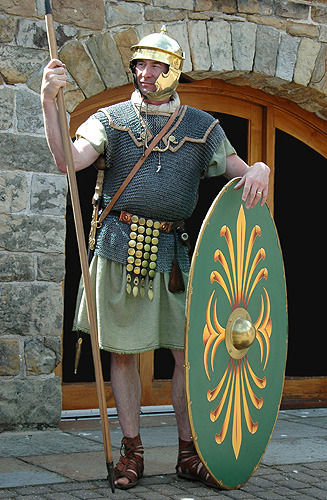peashooter85:The Forgotten Soldiers of Rome —- The Roman AuxiliariesWhen a person today imagines a R
peashooter85:The Forgotten Soldiers of Rome —- The Roman AuxiliariesWhen a person today imagines a Roman soldier, they typically envision the stereotypical Roman Legionary. A common staple of modern Hollywood movies, the Roman Legionary is easily identifiable by his strong but flexible plate armor, his very elaborate protective helmet, his myriad of weapons (short sword, dagger, two or three javelins), and most especially his large rectangular shield. In other words, the typical Roman soldier looks like this… While accurate for the typical Imperial era Roman Legionary, the Legions did not make backbone of the army. Roman Legions were Rome’s heavy infantry. Given the best training and equipment, the Roman Legions were the empire’s elite force of badasses; the best of the best. Most importantly the Roman Legions were exclusively manned by Roman citizens. Because the Roman Legions were recruited from a very select pool of men, the Legions themselves only made up around ¼th of the Roman Imperial Army. While the Roman Legions were a powerful force, the backbone of the Roman Army were the Auxiliaries. When Rome’s first Emperor (Augustus) built the Imperial Army he understood that the legions, while formidable, were not enough to rule a vast and mighty empire. After all 95% of the inhabitants living in the Roman Empire were not Roman. A diverse multicultural empire, the Romans dominated a realm consisting of Europe, North Africa, and the Middle East. At its height it spanned over 2.5 million square miles and was populated with over 88 million people.Clearly the Roman legions were not enough to maintain order and defend the empire alone. Thus the Auxiliaries were created. Recruited from the empire’s many non-Roman subjects, Auxiliaries were the common foot-soldiers of the empire. While the Roman Legions were the vanguard of the army, sent to smash down the enemies of the empire, the Auxiliaries were tasked with policing the empire, maintaining order, maintaining and manning the border posts, patrolling the empire, and defending the empire from foreign invaders. To accomplish these duties Roman Auxiliaries were issued simpler and lighter armor, making them Rome’s common light infantry who could respond to a threat quickly. The common equipment of the Auxiliary was of significantly lesser quality than that issued to Roman Legions. Rather than the plate armor of the Legions the typical Auxiliaryman wore a simple chain mail shirt or armor made of hardened leather. He carried a short sword, and rather than throwing javelins was armed with a common spear. Instead of the large Roman square shield used by the Legions, he carried a smaller circular or oval shaped shield. Finally his helmet was much simpler, with less protective features and usually made of brass or bronze rather than the stronger iron. Often Auxiliaries wore helmets that weren’t even Roman at all, but those common to the Celts, Germans, Africans, or Syrians. So rather than the heavily armed and tough looking Roman Legionary, the average Roman footsoldier typically looked more like this…The Auxiliaries also served another purpose. While the Romans created the best heavy infantry in the world, they were terribly lacking in other types of units, especially cavalry and missile troops. To fill in these gaps specialized soldiers were recruited to form specialty Auxiliary regiments. Such soldiers could include lancers, heavy cavalry, light cavalry, archers, slingers (use slingshots), and scouts. It is even noted that in the 2nd century AD, a unit of camel troops served in the province of Syria. Unless they were a high valued specialized unit, Roman auxiliaries tended to be payed less than their Legionary colleagues. However, after 25 years of service an Auxiliary soldier would be granted Roman citizenship and awarded a plot of land within the empire. While the recruitment of Auxiliaries provided the empire with a ready supply of common footsoldiers, the practice was often a double bladed sword. It was not uncommon for barbarians to train and learn to fight with the Roman Army as Auxiliaries, only to become rebels and future enemies of Rome. One such example was the German prince Arminius, who used his position as Auxiliary cavalry commander to trick the Romans into an ambush in the dense Teutoburg Forest. The resulting battle lead to the massacre of 20,000 Roman soldiers. -- source link
Tumblr Blog : peashooter85.tumblr.com
#history#ancient rome#roman army#ancient history#roman empire#soldiers#military
